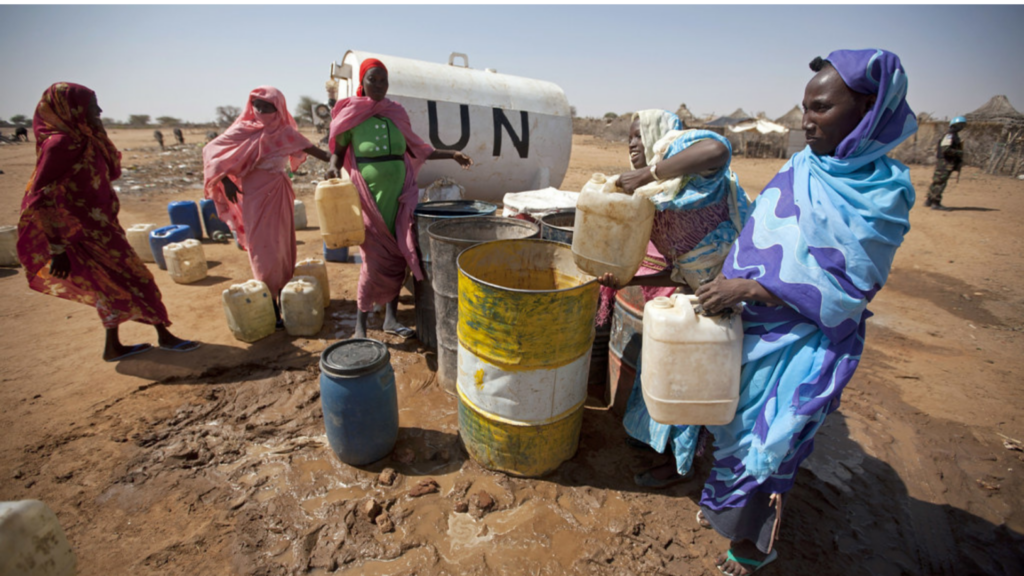Shifting Security Dynamics in Europe During the Russia-Ukraine Crisis and the Deceased US Presence
The security dynamics of Europe have totally shifted over the past decade (Commons Library, 2025a). Indeed, Russian moves against Ukraine—specifically, since 2022—have worked to underscore both the fragility of regional stability and Europe’s existing military structure’s limitation. Moreover, these tensions are compounded by the new policy of the United States, whose political leadership has recently signalled a reduction in military aid and deployment on the continent (Foy, 2025). Hence, the US military presence spiked temporarily following Russia’s invasion of Ukraine and will be expected to recede to pre-2022 levels, if not lower.
Against this context, diplomatic tensions have increased. Therefore, the UK, now outside the European Union, must collaborate tightly with its European partners in common defence but continues to be hindered by the capacity shortfalls. Moreover, disagreements over joint procurement and the complexity of establishing increased cooperation also complicate further accelerating an efficient pan-European reaction (Sandbu, 2025).
Consequently, this essay presents a risk analysis of Europe’s—and, by extension, the United Kingdom’s—ability to defend its sphere of influence in the new strategic environment. Drawing on various policy and research documents, including UK defence personnel numbers (Commons Library, 2024) and broader European security briefs, the analysis sets out weaknesses and strategic considerations. In particular, the United Kingdom, being a traditionally powerful country with military forces, has capacity shortages that limit its ability to provide unilateral regional security.
War in Ukraine and Shifting Alliances
When Russia invaded Ukraine on a mass scale in February 2022, it drastically remapped Europe’s geopolitics (Commons Library, 2025a). Consequently, European states levied sanctions and security assistance to Ukraine but, in doing so, laid bare both the strategic worth of the transatlantic relationship and the exposed state of Europe’s independent defence capabilities. Although the North Atlantic Treaty Organisation (NATO) remains the continent’s preeminent collective security arrangement, the United States has begun to retract its commitments (Foy, 2025).
Therefore, the reduced US influence underlines Europe’s necessity to build independent defence structures—an imperative that is symbolized by the slogan “Europe must be stronger together” (Sandbu, 2025). Meanwhile, one of Europe’s more capable military powers, the UK, shows signs of people and capability fatigue. Additionally, EU member state conflicts regarding defence cooperation speed and depth hamper effective strategic planning (Rachman, 2025).
The UK’s Military Posture: Facts and Constraints
Accordingly, the Army’s target for “full-time trained/trade-trained” personnel is set at 73,000, a reduction from the 82,000 figure indicated in 2015. As of April 2024, the actual number stands at approximately 72,510, which is about 1% below the target. Furthermore, the Royal Navy and Marines are experiencing a 5% shortfall compared to their target of 30,450 trained personnel. Meanwhile, the Royal Air Force has the most significant percentage deficit, standing at 10% below its target, highlighting difficulties in retaining specialist technical staff and pilots.
UK Defence Personnel Statistics, 2024
Moreover, persistent skill shortages—most officially termed “operational pinch points”—recur within main areas (Commons Library, 2024). Britain and other like-minded countries are enduring an over-hoped-for voluntary loss of troops at unimagined numbers not seen since the 1990s, making up part of the deficit. Consequently, as the country is called more and more on to contain or even thwart crises, such staff weaknesses reduce readiness.
Cost of Unilateral Action: Strains for Britain
Therefore, in the context of the ongoing conflict in Ukraine, the reduced role of the US is putting increased pressure on Europe. The UK cannot independently replace the capabilities provided by the US. Indeed, current figures indicate that there are challenges in meeting manpower targets. Moreover, high levels of voluntary turnover further complicate the ability to sustain extensive or prolonged operations without external support (Commons Library, 2024).
Meanwhile, while the UK needs to increase defence spending to modernize its military, the scope of equipment upgrade needs typically exceeds the available budget. Therefore, cooperative cost sharing mechanisms are still in their infancy, leaving British forces vulnerable to being overstretched. Additionally, the UK relies on the US for intelligence and high-tech munitions. A diminished US presence undermines these critical supports, creating a gap that European cooperation may struggle to fill in the short term.
Furthermore, the UK’s vision of being a “global force,” highlighted by its focus on the Indo-Pacific region, further spreads its resources. Hence, maintaining several regional commitments with limited manpower increases the risk that the adversaries could exploit potential weaknesses closer to Europe.
European Collaborative Efforts and Gaps
Significantly, the EU is more aware of the need for a united defence position. Indeed, ideas such as EU-level instruments of funding and industrial partnerships to buy arms are signs of attempts to raise joint capability (Rachman, 2025). Nevertheless, it moves forward in a stop-and-start fashion. Meanwhile, Poland and Germany are increasing spending on defence, but other members of the EU are resisting or being resisted by internal politics. Hence, the quilt work of defence endeavours follows the risk of blocking Europe’s combined response. Concurrently, Russia’s actions in Ukraine and experience with “grey zone” tactics (Commons Library, 2025a) underscore the potential vulnerabilities. Western allies must be united; any perceived gaps are likely to be taken advantage of by the Kremlin to advance its strategic agenda.
Risk Outlook and Potential Scenarios
Scenario A: Limited US Support & Fragmented EU Response
Here, the US partially withdraws and reduces broader military assistance, thereby exposing Europe to vulnerability. The UK, with domestic deficits, cannot alone deter Russia on NATO’s eastern frontier. Consequently, Europe’s response may be disjointed, particularly if states disagree on cost sharing.
Scenario B: Accelerated European Integration
Conversely, here, Europe capitalizes on the US drawdown as a catalyst for closer defence cooperation. Even outside of the EU, the UK moves in tandem with European allies on procurement, logistics, and strategy. Although differences among member states persist, momentum in common defence could, therefore, deter further Russian aggression.
Conclusion and Recommendations
Therefore, the ongoing Russian belligerence against Ukraine and the United States’ plans to reduce its presence in Europe highlights the vulnerability of existing European defence frameworks (Commons Library, 2025b; Sandbu, 2025). While the UK has considerable conventional and nuclear capability, the latest personnel data (Commons Library, 2024) indicates that the size and strength of the British military are not sufficient to be in a position to ensure stability in Europe on their own. Consequently, achieving actual security requires cooperation with allies, ranging from industrial enterprises, joint logistics, combined command arrangements, and a rethinking of the UK-EU defence relationship.
Furthermore, a strategic emphasis on reversing manpower deficiencies, reskilling technical skills (e.g., cybersecurity, precision-guided munitions), and improving intelligence interoperability could increase the UK’s contribution. Above all, bridging gaps between the UK and EU, even post-Brexit circumstances, becomes essential. Indeed, as regional threats evolve, integrated and adequately funded defence arrangements become not wishes, but necessities. Ultimately, the danger of doing nothing—letting Europe face a revanchist Russia with no collective deterrent—far outweighs any political or economic costs of closer cooperation.
Lastly, standing alone, the UK cannot support its sphere of influence as aid from the United States wanes; a mixture of policy reform and pan-European approaches could construct a more long lasting defence footing. Moreover, as experience implies, speed matters; competitors already stand to make gains from inner divisions and capacity shortfalls. Consequently, seizing the moment for unison action is urgent.
References
Ana Peres (2025). The geopolitics of trade tariffs: The new Trump presidency. House of Commons Library. Available at: https://commonslibrary.parliament.uk/the-geopolitics-of-trade-tariffs-the-new trump-presidency/
Gideon Rachman (2025). Europe’s response to the threat from Trump. Financial Times. Available at: https://www.ft.com/content/e50c7347-f42f-44fd-a739-d4a9ff91532c [Accessed 18 March 2025].
Henry Foy (2025). Nato’s Rutte meets Trump with Europe’s security on the line. Financial Times. Available at: https://www.ft.com/content/63dbd391-fff1-4653-8fc0-a96c6afadbc5 [Accessed 18 March 2025].
Martin Sandbu (2025). Europe must be stronger together. Financial Times. Available at: https://www.ft.com/content/45083bd7-6bd4-4d54-826e-dcc5901c3962 [Accessed 18 March 2025].
Esme Kirk-Wade (2024). UK defence personnel statistics. House of Commons Library. Available at: https://commonslibrary.parliament.uk/research-briefings/cbp-7930/ [Accessed 18 March 2025].
House of Commons Library (2025). Countering Russian influence in the UK. Available at: https:// commonslibrary.parliament.uk/research-briefings/cbp-9472/ [Accessed 18 March 2025].



